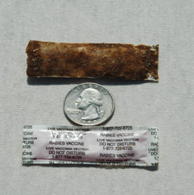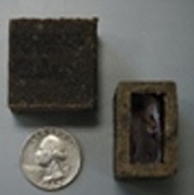RACCOON RABIES VACCINATION SET FOR SEPTEMBER


Sachet bait (left) containing the vaccine. Block-type baits
(right) will be distributed in selected more urban locations by hand
West Virginia's raccoon population is about to receive its annual dose of rabies vaccine. As in previous years, the vaccine will be dropped in a target area that covers a wide corridor through the central part of the state, extending from the northern panhandle to the southern coalfields.
In order to control the spread of raccoon rabies, a major source of rabies in West Virginia, the United States Department of Agriculture-Animal Plant Health Inspection Service-Wildlife Services, in cooperation with local health departments, the West Virginia Department of Agriculture, The West Virginia Division of Natural Resources, the Centers for Disease Control and Prevention, and West Virginia Department of Health and Human Resources will distribute rabies vaccine-laden baits beginning in early September to help stop the westward spread of raccoon-strain rabies in the state.
Aerial baiting is scheduled to begin on September 11 and conclude around September 18. Hand baiting with the block-type baits will begin in early September and continue until completed. Distribution of baits is weather dependent and inclement weather may result in extended bait distributions.
Each vaccine-laden bait consists of a plastic sachet containing the vaccine and covered with a fish-meal polymer. The swath of baiting will cover the northern panhandle counties and continue down the central portion of WV to the southern-most counties. Counties that will receive baits may include: Barbour, Boone, Braxton, Brooke, Clay, Doddridge, Fayette, Greenbrier, Hancock, Harrison, Kanawha, Lewis, Marion, Marshall, McDowell, Mercer, Monongalia, Nicholas, Ohio, Pleasants, Pocahontas, Raleigh, Randolph, Ritchie, Summers, Taylor, Tyler, Upshur, Webster, Wetzel and Wyoming.
Most of these baits will be distributed by low flying aircraft. Block-type baits will be distributed in selected more urban locations by hand.
Each bait will have a toll-free number printed on its side so that anyone finding the bait can obtain information by calling this number. Residents are asked to leave baits alone and to keep pets confined or on a leash during the baiting period and up to five days after baiting. This gives raccoons the opportunity to locate and consume these baits. In particular, dogs are attracted to the baits and will occasionally eat them. The baits are not harmful to pets. Do not try to take baits away from your pet. Please keep the following information in mind:
⢠Know what the bait looks like (see photos above) The primary bait distributed by air looks like a ketchup package with the exterior covered with a fine brown-colored fish meal coating. The block-type bait is a hard, brown-colored fish meal polymer shell. This bait resembles a fig cookie. Inside is a smaller version of a ketchup package which contains the vaccine.
⢠Instruct children to leave the baits alone.
⢠Do not attempt to take baits away from your pet; you may be bitten. The bait is not harmful to your pet. If by chance numerous baits are consumed, your pet may develop an upset stomach.
⢠If baits are found in areas frequented by pets or children, toss them into brushy or forested cover. Damaged baits can be disposed of in trash. It is recommended that anyone handling baits wear gloves or use a paper towel.
⢠If a person is exposed to the actual vaccine (red to purple liquid), wash with soap and water any areas of the skin that came into contact with the vaccine. Contact your local health department or the phone number on the bait.
For more information: call the Mid-Ohio Valley Health Department or the West Virginia Department of Health and Human Resources at 1-800-423-1271.